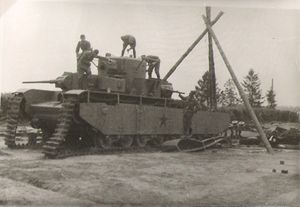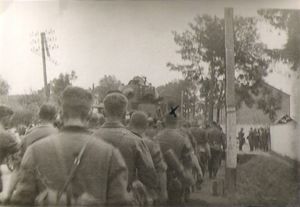1941/Juni/25/en: Unterschied zwischen den Versionen
| (9 dazwischenliegende Versionen desselben Benutzers werden nicht angezeigt) | |||
| Zeile 9: | Zeile 9: | ||
}} | }} | ||
[[File:Buch S 109 a 1941-06-22...1942-07-28 vvv Orte Vormarsch (Benary S. 29 m.eig.Erg.).jpg|thumb|<span class="TgbT"></span>Advance of 257. I.D.<ref>[[Anhang/Literatur#Benary|Benary]] p. 29</ref> ''For long periods of time, the division was only occupied with the advance and not involved in combat; moreover, the author was predominantly in the Führerreserve or with the Stomarsch for traffic control.'']] | [[File:Buch S 109 a 1941-06-22...1942-07-28 vvv Orte Vormarsch (Benary S. 29 m.eig.Erg.).jpg|thumb|<span class="TgbT"></span>Advance of 257. I.D.<ref>[[Anhang/Literatur#Benary|Benary]] p. 29</ref> ''For long periods of time, the division was only occupied with the advance and not involved in combat; moreover, the author was predominantly in the Führerreserve or with the Stomarsch for traffic control.'']] | ||
| − | [[File:1941-06-22+ russische Flak oder Ratsch-bumm.jpg|thumb| <span class="TgbA"></span>''June 1941: It seems to be the author inspecting a Russian gun ( | + | <div class="thumb tright"><div class="thumbinner" style="width:302px;">[https://fotopolska.eu/Most_drogowy_Radymno?f=1026271-foto <iframe k="all" p="fotopolska.eu/foto/m/1026/1026271.jpg" w="200" h="284"/>]<div class="thumbcaption"><span class="TgbZ"></span>''Bridge of Radymno (photo from 1940)''</div></div></div> |
| − | [[File:1941-06-22+ russische Panzerreparaturwerkstatt b Lemberg.jpg|thumb| <span class="TgbT"></span>''June 1941:'' captured [[w:en:T-35|T-35]] (with 3 guns)<ref>in the diary erroneously called {{Gerade|KW-1}}</ref> | + | [[File:1941-06-22+ russische Flak oder Ratsch-bumm.jpg|thumb| <span class="TgbA"></span>''June 1941: It seems to be the author inspecting a Russian air defense gun (obviously a [[w:en:76 mm air defense gun M1938|76 mm M1938]])'']] |
| + | [[File:1941-06-22+ russische Panzerreparaturwerkstatt b Lemberg.jpg|thumb| <span class="TgbT"></span>''June 1941:'' captured [[w:en:T-35|T-35]] (with 3 guns)<ref>in the diary erroneously called {{Gerade|KW-1}}</ref> ''in a'' Russian tank repair workshop near Lemberg, captured with 12 heavy, 8 light, 16 medium [tanks] and 45 [[w:en:Maybach#1940–1945|Maybach]] engines, some still packaged]] | ||
Three days later we begin our march and cross the San at Radymno. The bridge had been captured by surprise and is completely undamaged. Soon we march past the first shot-up Soviet tank. | Three days later we begin our march and cross the San at Radymno. The bridge had been captured by surprise and is completely undamaged. Soon we march past the first shot-up Soviet tank. | ||
{{Tr|Phil Price}} | {{Tr|Phil Price}} | ||
| − | On this road, an episode that was later much derided had taken place. Our division, which had been replenished with many recruits, was advancing when the command " | + | On this road, an episode that was later much derided had taken place. Our division, which had been replenished with many recruits, was advancing when the command "farmer's cart to the front" was shouted from the top. The call gradually spread to the rear, but was slowly mutilated until it became "armoured car from the front". The columns became agitated. An eager messenger, wanting to get the tank warning through more quickly, grabbed his flare gun to shoot the tank warning signal. In his excitement, however, he made a mistake and fired a whistle cartridge meaning "gas alarm". Now the drilled measures of gas protection ran automatically. The men put on their gas masks and threw over their gas tarpaulins. All in all, there was a great deal of confusion, which delayed the advance of the division by almost an hour, because due to the erroneous tank alarm, whole columns of vehicles had driven off the road into cover and now had to regroup. |
Anyone who has practised passing messages through a marching column in peacetime knows the grotesque mutilations with which such messages arrive in the end. In manoeuvres this was always cause for laughter. In war it can be life-threatening. | Anyone who has practised passing messages through a marching column in peacetime knows the grotesque mutilations with which such messages arrive in the end. In manoeuvres this was always cause for laughter. In war it can be life-threatening. | ||
| − | {{Tr| | + | {{Tr|DeepL.com and the editor}} |
| − | The heat is searing. Under a burning sun we are marching 25 to 30 km East every day. But our kit is light, because we’ve only got the essentials with us. Shortly we | + | The heat is searing. Under a burning sun we are marching 25 to 30 km East every day. But our kit is light, because we’ve only got the essentials with us. Shortly we stopped overnight in a barn. I lay on the bare floor, using my bread bag as a pillow for my head. Next to me was Major Haarhaus, but this arrogant (or maybe somewhat inhibited?) Officer did not exchange one word with me. |
I see the first Soviet prisoners of war. About a hundred men, mainly Mongols. They sit or lie in the grass, dumb and apathetic. Their flat, expressionless faces give away nothing about what they’re feeling, only their pointed dark eyes look this way and that, watching with foreboding and mistrust. One senses the restrained ferocity of these grim races. Mongols in Galicia. The Asiatic hordes from the steppes are once more standing at the gates of Europe! Now I understand why I am fighting this war: the salvation of European Culture from the Unculture of the Steppes; the salvation of Western Christianity from the godlessness of Bolshevism. | I see the first Soviet prisoners of war. About a hundred men, mainly Mongols. They sit or lie in the grass, dumb and apathetic. Their flat, expressionless faces give away nothing about what they’re feeling, only their pointed dark eyes look this way and that, watching with foreboding and mistrust. One senses the restrained ferocity of these grim races. Mongols in Galicia. The Asiatic hordes from the steppes are once more standing at the gates of Europe! Now I understand why I am fighting this war: the salvation of European Culture from the Unculture of the Steppes; the salvation of Western Christianity from the godlessness of Bolshevism. | ||
| Zeile 28: | Zeile 29: | ||
[[File:1941-06-22+ Vormarsch Ri. Lemberg.jpg|thumb| <span class="TgbA"></span>''June 1941: Advance towards Lemberg (the "x" does '''not''' signify the author)'']] | [[File:1941-06-22+ Vormarsch Ri. Lemberg.jpg|thumb| <span class="TgbA"></span>''June 1941: Advance towards Lemberg (the "x" does '''not''' signify the author)'']] | ||
| + | [[File:1941-06-22+ vvv Album 17.A. (1) Nach dem Durchstoß durch die Grenzbefestigungen folgen lange Märsche.jpg|thumb| <span class="TgbZ"></span>After breaking through the border fortifications, long marches follow<ref>[[Anhang/Literatur#AOK17|Armeeoberkommando 17: Mit unserer Arme in Russland vom San bis zum Donez. Druck: Héliogravure Aulard, Paris 1942]]</ref>]] | ||
[[File:1941-08-07+ Vormarschstraße.jpg|thumb| <span class="TgbT" id=""></span>Advance road; ''on the left a destroyed armoured car [[w:en:BA-10|BA-10]]'']] | [[File:1941-08-07+ Vormarschstraße.jpg|thumb| <span class="TgbT" id=""></span>Advance road; ''on the left a destroyed armoured car [[w:en:BA-10|BA-10]]'']] | ||
We're approaching Lemberg. Traces of fierce fighting are becoming ever clearer. Before us in the bright sunshine is the road to Lemberg. The scenes are typical of those of all routes of advance: the asphalt surface has been partially ripped up by shells or bombs. Trees have been stripped; they extend their few naked branches sadly into the sky. The masts of the telephone lines lie bent by the roadside, the wires hang down in loose bundles. In the ditch there are shot-up tanks, crashed vehicles and an anti-tank gun crushed by tanks. Every now and then we pass bloated horse carcasses, which quickly decompose in heat of summer and spread a sweetish stench. Here the brash humour of my private, Willi Neuhauß, who drives a beer cart in Berlin, makes the men laugh with his long-drawn-out cry "Kadaaaaaver!" | We're approaching Lemberg. Traces of fierce fighting are becoming ever clearer. Before us in the bright sunshine is the road to Lemberg. The scenes are typical of those of all routes of advance: the asphalt surface has been partially ripped up by shells or bombs. Trees have been stripped; they extend their few naked branches sadly into the sky. The masts of the telephone lines lie bent by the roadside, the wires hang down in loose bundles. In the ditch there are shot-up tanks, crashed vehicles and an anti-tank gun crushed by tanks. Every now and then we pass bloated horse carcasses, which quickly decompose in heat of summer and spread a sweetish stench. Here the brash humour of my private, Willi Neuhauß, who drives a beer cart in Berlin, makes the men laugh with his long-drawn-out cry "Kadaaaaaver!" | ||
Version vom 5. April 2022, 17:40 Uhr
| GEO & MIL INFO | ||||
|---|---|---|---|---|
| Radymno | ||||
| Lemberg | ||||
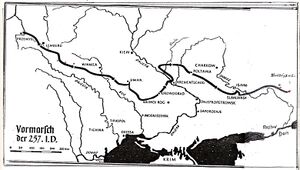
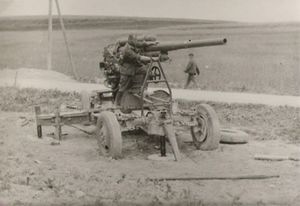
Three days later we begin our march and cross the San at Radymno. The bridge had been captured by surprise and is completely undamaged. Soon we march past the first shot-up Soviet tank.
On this road, an episode that was later much derided had taken place. Our division, which had been replenished with many recruits, was advancing when the command "farmer's cart to the front" was shouted from the top. The call gradually spread to the rear, but was slowly mutilated until it became "armoured car from the front". The columns became agitated. An eager messenger, wanting to get the tank warning through more quickly, grabbed his flare gun to shoot the tank warning signal. In his excitement, however, he made a mistake and fired a whistle cartridge meaning "gas alarm". Now the drilled measures of gas protection ran automatically. The men put on their gas masks and threw over their gas tarpaulins. All in all, there was a great deal of confusion, which delayed the advance of the division by almost an hour, because due to the erroneous tank alarm, whole columns of vehicles had driven off the road into cover and now had to regroup.
Anyone who has practised passing messages through a marching column in peacetime knows the grotesque mutilations with which such messages arrive in the end. In manoeuvres this was always cause for laughter. In war it can be life-threatening.
The heat is searing. Under a burning sun we are marching 25 to 30 km East every day. But our kit is light, because we’ve only got the essentials with us. Shortly we stopped overnight in a barn. I lay on the bare floor, using my bread bag as a pillow for my head. Next to me was Major Haarhaus, but this arrogant (or maybe somewhat inhibited?) Officer did not exchange one word with me.
I see the first Soviet prisoners of war. About a hundred men, mainly Mongols. They sit or lie in the grass, dumb and apathetic. Their flat, expressionless faces give away nothing about what they’re feeling, only their pointed dark eyes look this way and that, watching with foreboding and mistrust. One senses the restrained ferocity of these grim races. Mongols in Galicia. The Asiatic hordes from the steppes are once more standing at the gates of Europe! Now I understand why I am fighting this war: the salvation of European Culture from the Unculture of the Steppes; the salvation of Western Christianity from the godlessness of Bolshevism.
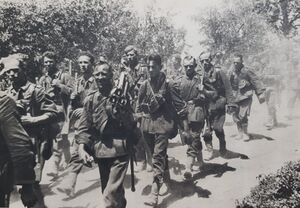
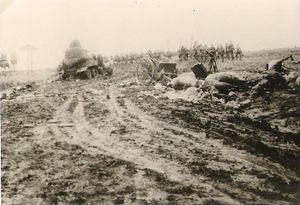
We're approaching Lemberg. Traces of fierce fighting are becoming ever clearer. Before us in the bright sunshine is the road to Lemberg. The scenes are typical of those of all routes of advance: the asphalt surface has been partially ripped up by shells or bombs. Trees have been stripped; they extend their few naked branches sadly into the sky. The masts of the telephone lines lie bent by the roadside, the wires hang down in loose bundles. In the ditch there are shot-up tanks, crashed vehicles and an anti-tank gun crushed by tanks. Every now and then we pass bloated horse carcasses, which quickly decompose in heat of summer and spread a sweetish stench. Here the brash humour of my private, Willi Neuhauß, who drives a beer cart in Berlin, makes the men laugh with his long-drawn-out cry "Kadaaaaaver!"
|
Editorial 1938 1939 1940 1941 1942 1943 1944 1945 1946 1947 1948 1949 Epilog Anhang |
|
January February March April May June July August September October November December Eine Art Bilanz Gedankensplitter und Betrachtungen Personen Orte Abkürzungen Stichwort-Index Organigramme Literatur Galerie:Fotos,Karten,Dokumente |
|
1. 2. 3. 4. 5. 6. 7. 8. 9. 10. 11. 12. 13. 14. 15. 16. 17. 18. 19. 20. 21. 22. 23. 24. 25. 26. 27. 28. 29. 30. 31. Erfahrungen i.d.Gefangenschaft Bemerkungen z.russ.Mentalität Träume i.d.Gefangenschaft Personen-Index Namen,Anschriften Personal I.R.477 1940–44 Übersichtskarte (Orte,Wege) Orts-Index Vormarsch-Weg Codenamen der Operationen im Sommer 1942 Mil.Rangordnung 257.Inf.Div. MG-Komp.eines Inf.Batl. Kgf.-Lagerorganisation Kriegstagebücher Allgemeines Zu einzelnen Zeitabschnitten Linkliste Rotkreuzkarte Originalmanuskript Briefe von Kompanie-Angehörigen |
- ↑ Benary p. 29
- ↑ in the diary erroneously called KW-1
- ↑ Armeeoberkommando 17: Mit unserer Arme in Russland vom San bis zum Donez. Druck: Héliogravure Aulard, Paris 1942

